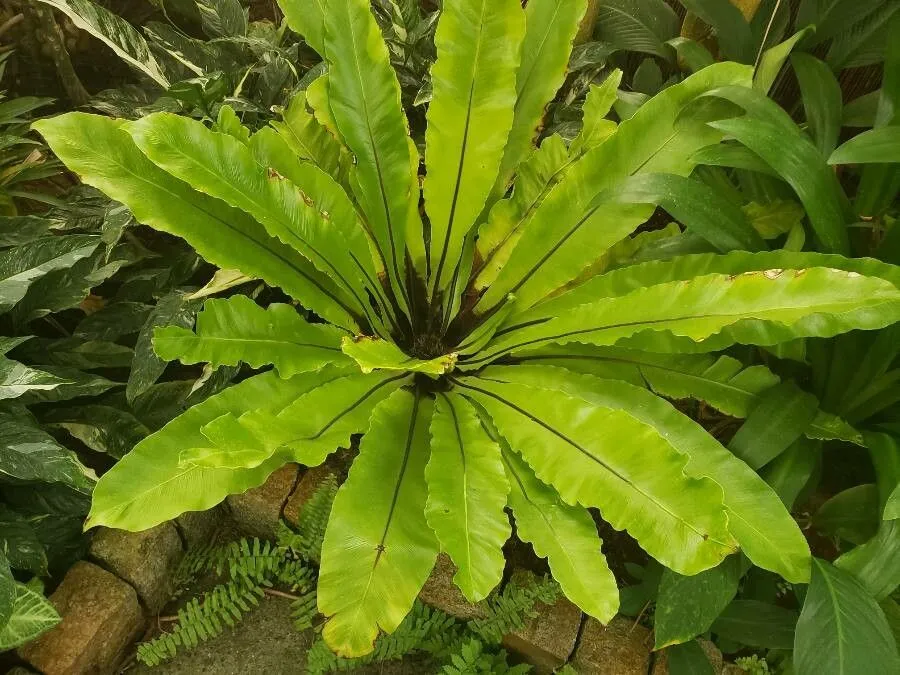
Author: L.
Bibliography: Sp. Pl.: 1079 (1753)
Year: 1753
Status: accepted
Rank: species
Genus: Asplenium
Vegetable: Unknown
Observations: Malesia to N. & NE. Queensland
The Bird’s-nest fern, scientifically known as Asplenium nidus, is an enchanting and exotic plant that graces various tropical regions with its lush, vibrant foliage. It was first described and classified in the year 1753 and has since captivated botanists and plant enthusiasts alike.
Belonging to the family Aspleniaceae, the Bird’s-nest fern is renowned for its unique and striking appearance. Its common name derives from the way its fronds unfurl in a circular pattern, resembling a bird’s nest. This distinctive growth habit makes it a popular ornamental plant, often admired for its broad, undivided fronds that create a rosette-like structure.
The natural habitat of Asplenium nidus spans across Malesia to northern and northeastern Queensland. In these tropical locales, the fern thrives under the canopy of lush rainforests, where it benefits from the humid and shaded environment. This fern is often found growing on trees as an epiphyte, though it can also grow terrestrially, taking root in the rich, organic matter on the forest floor.
Adapted to such environments, the Bird’s-nest fern has evolved to capture and retain water and nutrients efficiently. Its broad, leathery fronds not only collect falling debris which decomposes to supply nutrients, but also help to funnel water to the plant’s root system, nestled at the base of the rosette. This clever adaptation ensures that the fern can sustain itself in varying conditions within its native range.
Growing a Bird’s-nest fern indoors can bring a touch of the tropics to any space. To mimic its natural habitat, it is best to provide it with indirect sunlight and a humid environment. Regular misting and maintaining a consistent moisture level in the soil will help it thrive. It is also important to remember that this fern prefers slightly acidic to neutral soil and can suffer if exposed to direct sunlight or overly dry conditions.
In summary, the Bird’s-nest fern (Asplenium nidus) is a fascinating and beautiful plant that hails from the lush, tropical forests of Malesia to northeastern Queensland. Its unique rosette form and adaptive features make it a cherished addition to both natural and cultivated environments, where it continues to capture the imagination of plant lovers around the world.
Eng: hawai’i birdnest fern, bird’s-nest fern, nest fern
Swe: fågelbobräken
En: Bird’s-nest fern, Nest fern, Hawai’I birdnest fern, Bird’s Nest Fern
Ar: سرخس عش الطير
Zh: 巢蕨, 臺灣山蘇花
Fi: Pesäraunioinen
Fr: Fougère nid d’oiseau
Id: Paku sarang burung
Ms: Sakat-sakat
Ml: അസ്പ്ലേനിയം നിഡസ്
Fa: سرخس لانه پرنده
Pl: Zanokcica gniazdowa
Sv: Fågelbobräken
Zh-tw: 臺灣山蘇花
Th: ข้าหลวงหลังลาย
To: Hakato
Taken Aug 16, 2022 by Fabrice Rubio (cc-by-sa)
Taken Aug 26, 2021 by William Coville (cc-by-sa)
Taken Jul 7, 2022 by Andrzej Konstantynowicz (cc-by-sa)
Taken Jan 13, 2022 by William Coville (cc-by-sa)
Taken Jun 25, 2022 by Sudesh Gunarathna (cc-by-sa)
Taken Dec 15, 2021 by Matthieu Deschamps (cc-by-sa)
Taken Dec 15, 2021 by Matthieu Deschamps (cc-by-sa)
Taken May 22, 2021 by Paul (cc-by-sa)
Taken Aug 15, 2018 by helene caze (cc-by-sa)
Taken Aug 15, 2018 by helene caze (cc-by-sa)
Taken Jun 23, 2009 by EOL − Zoya Akulova (cc-by-nc)
Taken Aug 6, 2021 by Ball Darren (cc-by-sa)
Taken Aug 16, 2022 by Fabrice Rubio (cc-by-sa)
Taken Sep 14, 2015 by EOL − Stuart Cable (cc-by-nc)
Taken Aug 15, 2018 by helene caze (cc-by-sa)
Taken Oct 24, 2022 by Tristan Jaton-Maria (cc-by-sa)
Taken Aug 6, 2020 by Dieter Albrecht (cc-by-sa)
Taken Jul 18, 2021 by Mégan Sanson (cc-by-sa)
Taken May 5, 2017 by Rémi Knaff (cc-by-sa)
Taken Apr 19, 2022 by manuseitz (cc-by-sa)
© copyright of the Board of Trustees of the Royal Botanic Gardens, Kew.
© copyright of the Board of Trustees of the Royal Botanic Gardens, Kew.
© copyright of the Board of Trustees of the Royal Botanic Gardens, Kew.
Family: Myrtaceae Author: (F.Muell.) K.D.Hill & L.A.S.Johnson Bibliography: Telopea 6: 402 (1995) Year: 1995 Status:…
Family: Rubiaceae Author: Pierre ex A.Froehner Bibliography: Notizbl. Bot. Gart. Berlin-Dahlem 1: 237 (1897) Year:…
Family: Sapindaceae Author: Koidz. Bibliography: J. Coll. Sci. Imp. Univ. Tokyo 32(1): 38 (1911) Year:…
Family: Asteraceae Author: A.Gray Bibliography: Pacif. Railr. Rep.: 107 (1857) Year: 1857 Status: accepted Rank:…
Family: Fabaceae Author: Medik. Bibliography: Vorles. Churpfälz. Phys.-Ökon. Ges. 2: 398 (1787) Year: 1787 Status:…
Family: Aspleniaceae Author: (Cav.) Alston Bibliography: Bull. Misc. Inform. Kew 1932: 309 (1932) Year: 1932…